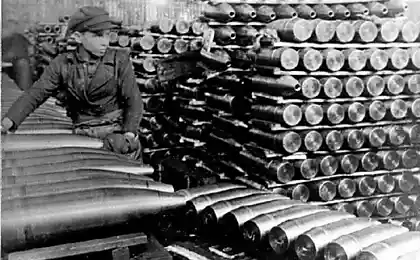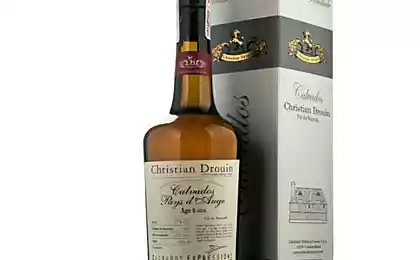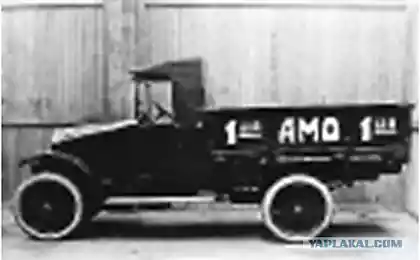1431
Production of Calvados
Calvados - it's apple or pear brandy, which is produced by the distillation of cider from the French region of Lower Normandy.
Every year in Normandy spreads around 3 million bottles of Calvados different periods of exposure. Especially love it in Germany, Japan, the United States and in Russia.
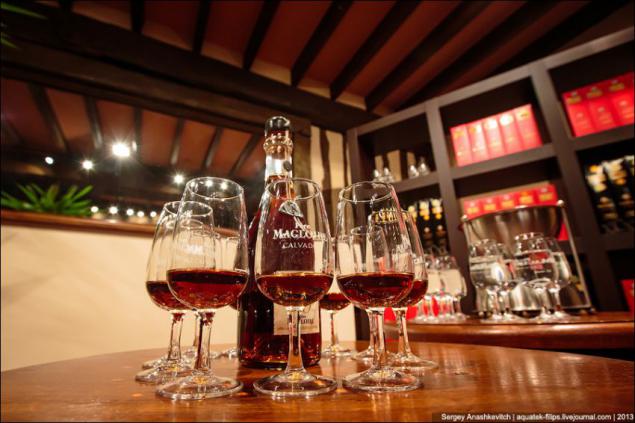
Calvados definitely should appeal to all fans of Steve Jobs and the products Apple. After Calvados is made from apples and many images associated with it there is an apple. However, not bitten. In the picture a basement distilerii Boulard.

With what begins Calvados? And it begins with Calvados. This department in Normandy, whose name and named the drink. And calvados can be called only one drink that is made in this department (by analogy with cognac and champagne). Everything else - the apple brandy. It is here that millions of apples are grown, and then finds a second life in the barrel and bottle. Like most other regional French food with a long tradition of manufacturing, Calvados is produced in strict accordance with the system of Appellation d'Origine Controlee, or AOC (the name translates as controlled origin). It is a set of rules that guarantee the authenticity of the product made in a particular area and determine the methods of its production as close to traditional. There are three appellation Calvados - the base (about 70% of total production), Pays d'Auge and Domfronte. This Pays d'Auge the highest quality (in detail about the differences I will discuss below) and Domronte content pears in Calvados with a share of at least 30%
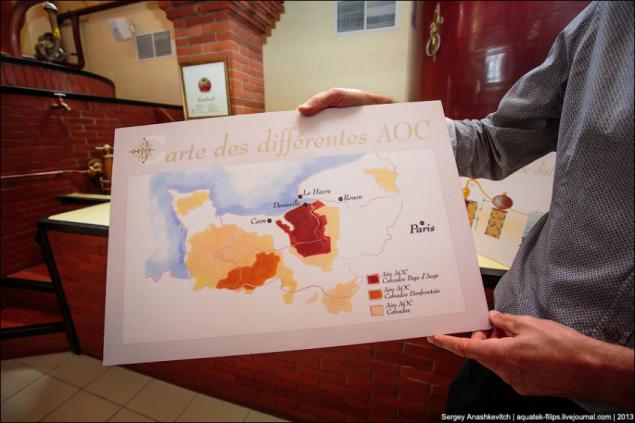
Basis calvados apples. Manufacturers use only small and very fragrant apples. They are called "apples for cider." In Normandy grown hundreds of varieties of apples, but only 48 of them are recommended in the Pays d'Auge. Unlike wine, the production of which use one or only a few grapes for calvados, a combination of aromas and flavors of many varieties.
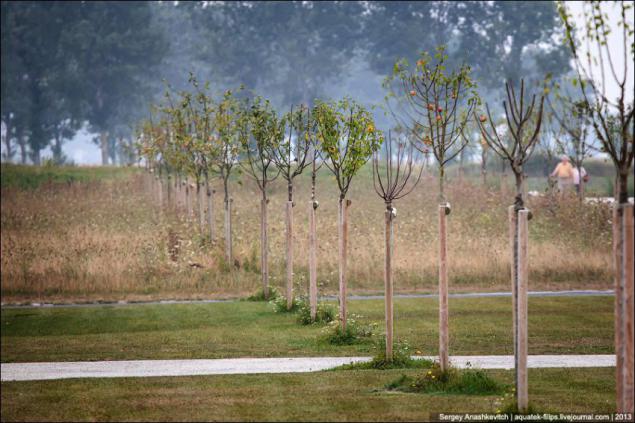
Depending on the acidity, bitterness, sugar and tannins, apples for Calvados is divided into four categories - bitter, bittersweet, sweet and sour. Manufacturers, strictly following traditions grow from 20 to 40 varieties of apples. Calvados Domfronte to grow these special varieties of pears.

Only a combination of different varieties of apples, calvados acquire the necessary softness, aroma and rich flavor. Normally it takes 10% of bitter apples, 70% of sweet and sour, slightly sweet, and around 20% acidic. In Domronte use 30 percent or more of pears. This Calvados is a more fruity. Apple harvest season is in September.
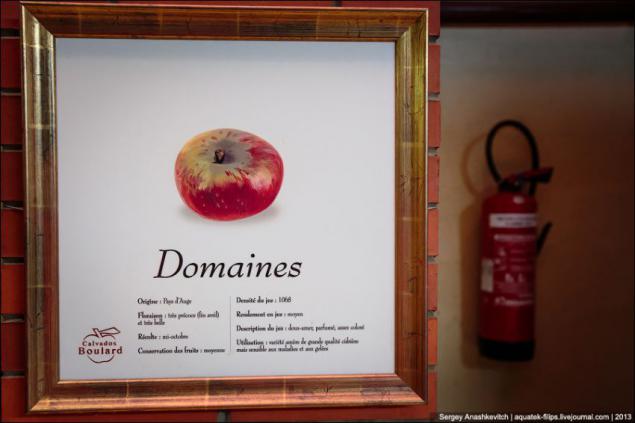
Between apples and calvados is another intermediate - cider. To obtain it, the apples after harvest and washing must be crushed or ground. To this end, the apples fall into a special press, grinding them to the desired consistency. After grinding, the pulp (or fruit mash) is several hours in a special container, where it is maceration. What is it for? The fact that most of the taste and flavor is obtained from the fruit peel. After maceration the pulp goes to press where the juice is separated from the pomace. From one tonne of apples get about 650 liters of juice.
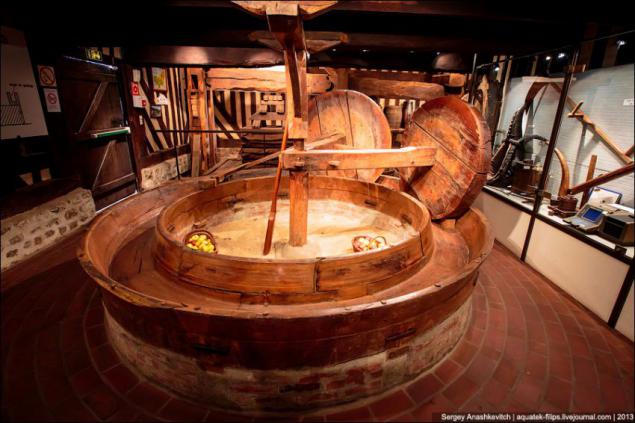
. The next stage - fermentation of cider. To do this, the juice is poured into oak barrels of large size, where it is about 6 weeks. Top manufacturers fermented cider longer, and sometimes even a little stand in front, followed by distillation. Large manufacturers usually do not grow apples and cider making, purchasing it as a raw material in the tested farms appellation.
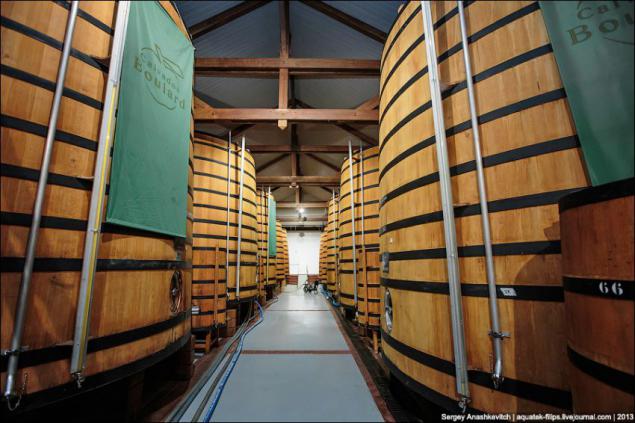
In the production of cider monitored alcohol content, which must be at least 4, 5 percent. Some manufacturers also bring it to 6-7 percent.

Workbook, which recorded figures during fermentation cider
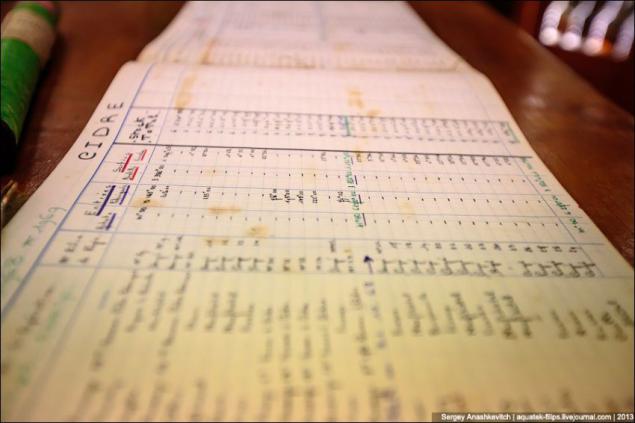
Once the cider is ready, it's time to distillation. Only a small amount of time in the year, you must get the keys of the premises with alembics. All other months, they will wait for the next season
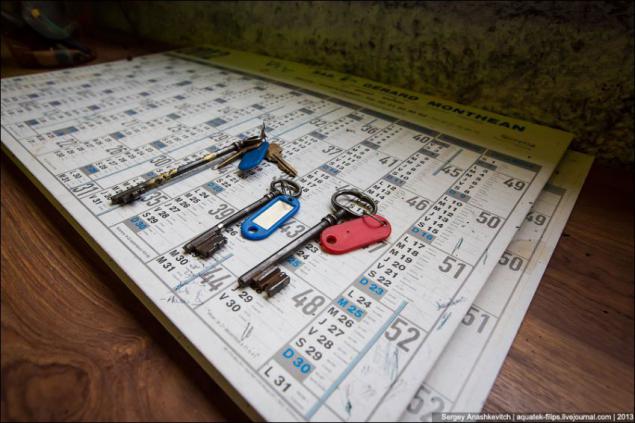
so ready to carry the cider distillery, where it will be subjected to distillation. There are two kinds of distillation - distillation alambikah Charente type and a direct continuous distillation in the cube. For the Calvados produced in the Pays d'Auge appellation obligatory double distillation. This process is more complex from a technical point of view, a long and consuming more time than single distillation. But it makes Calvados very different in quality.
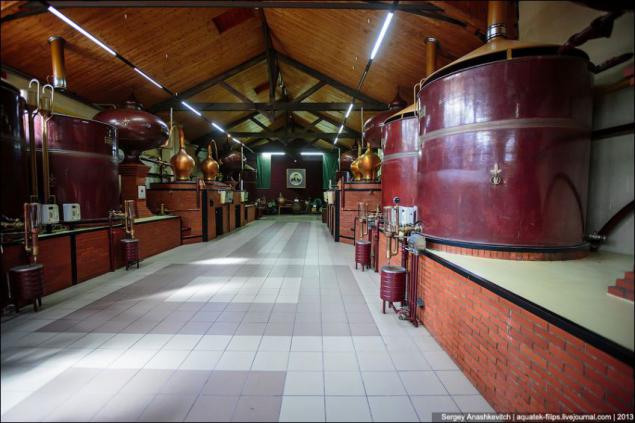
How is distillation? First, the cider is placed in a tank called shof cider (pictured maroon capacity on brick "hourglass" in the middle). Where cider is preheated using the vapor coming from the bottom. From cider is fed by gravity into the cube on the right (it is not visible, it is inside the brick structure with oven below). In fact, this pot with a helmet on top. The helmet rectified pair of cider, which go up and then move to the condenser tube (left maroon capacity). Inside this coil is placed in cold water. Here, a pair of alcohol and condensed into a liquid, which enters the holding tank
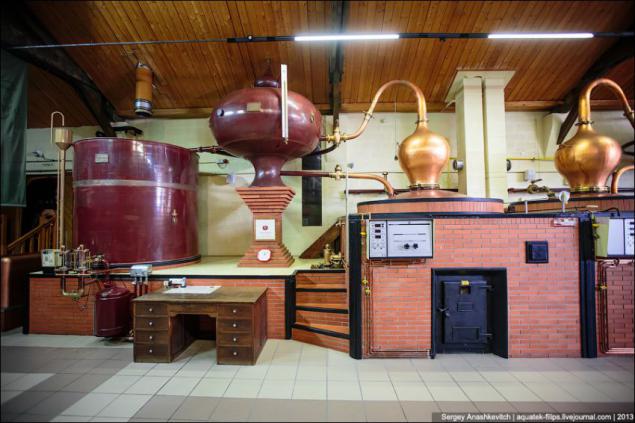
Distillery cellar master Richard talks about the distillation of Calvados
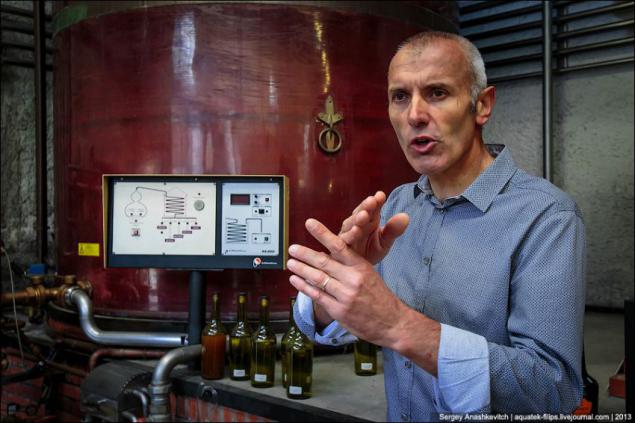
The furnace, which is located above the boiler with cider. Previously used as fuel wood, but now gas.
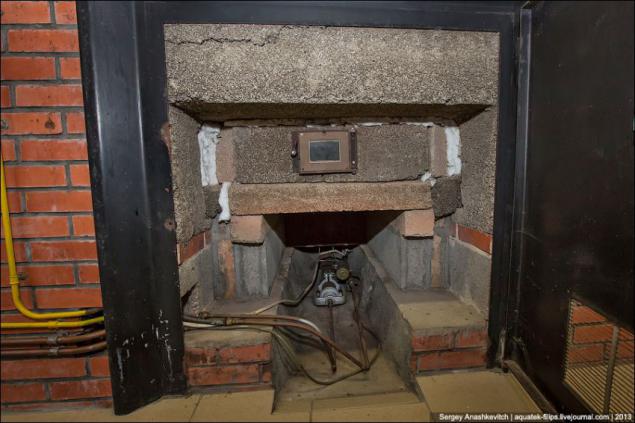
The sensors on the pipeline leading to the coil. That moved him a pair of alcohol

Does this mean that after the distillation of Calvados is bottled and fall on the table? In no case! This is only the beginning of his long journey. Then begins a long life in a barrel ...
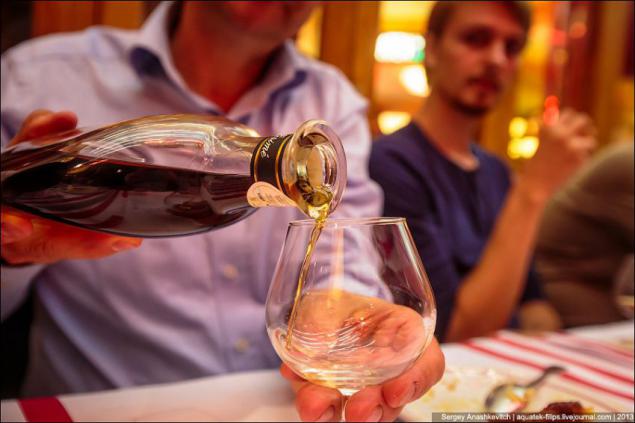
Calvados leaves alambik colorless. And he has not yet called Calvados, but the de-vie (water of life). At the request of the appellation Calvados be kept for at least two years in oak barrels. Why is this done? At a young Calvados strong aroma of fresh apple, and it is transparent. Now he needs to evolve to give color and flavor to balance its flavors derived from the oak barrels. In addition, the barrel gives the drink amber hues. As a result of the interaction of alcohol, wood and air Calvados gets subtlety of aromas and full flavor.
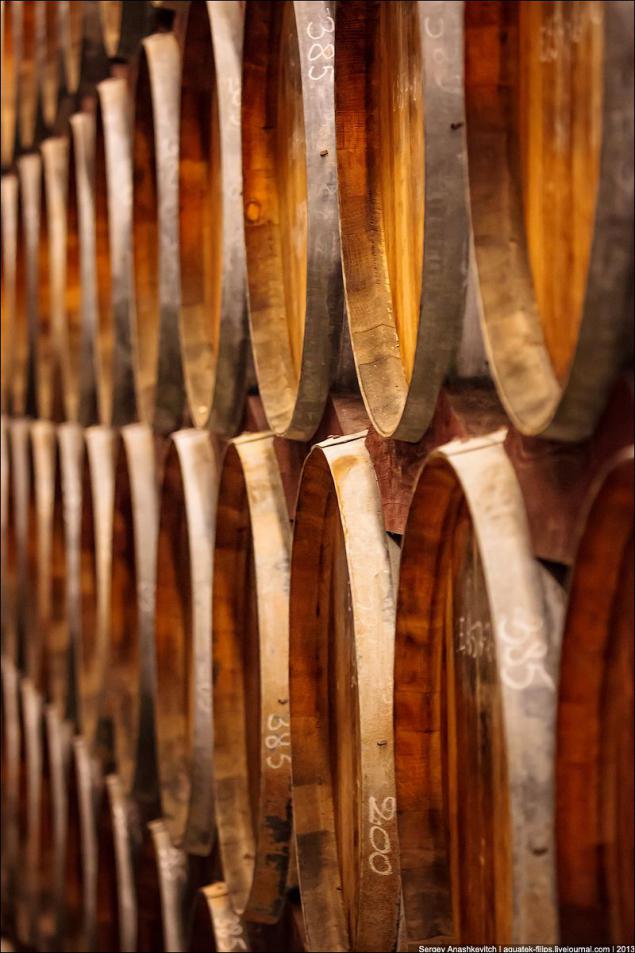
There are many types of barrels - from huge to small containers 300 and 400 liter. Barrels may be different calcination degrees, new, secondary or older.
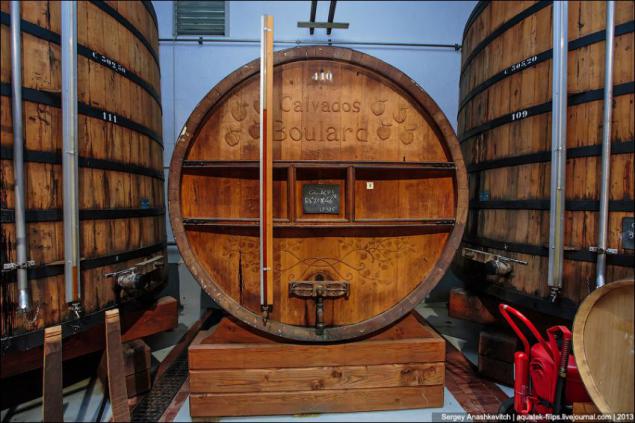
Young alcohols usually kept in new barrels from which they receive the necessary counterbalancing tone tannins and aromas. And only then Calvados poured into older barrels.

In general we must say that not as a wine Calvados lives all the time in a barrel. He is regularly poured, mixed with other Calvados, spending assemblage. Behind all this every day watching the cellar master, constantly taking samples and tasting flavors and taste.
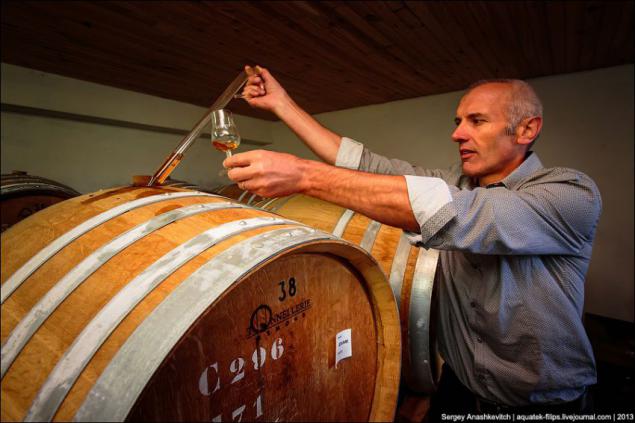
Each barrel has its own marking. For example, here it indicates that it has a capacity of 295 liters, the height of the middle part of 70 cm. Now it is filled to the level of beverage 57 centimeters and its barrel 265 liters. Fortress 54 degrees. The barrel millezimnyh drink that flooded in 2004. Millezimnyh means that it is the drink of one year is not mixed with any other.
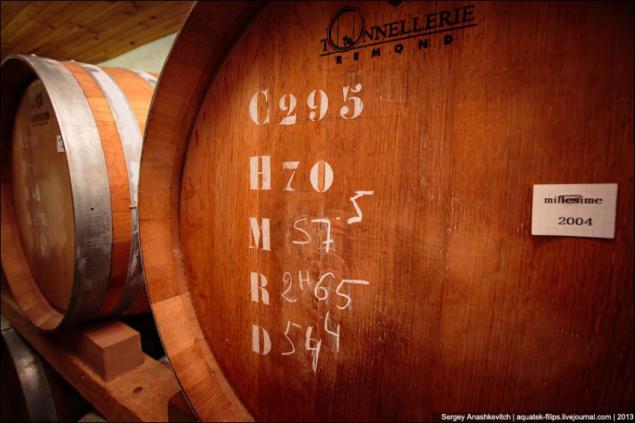
This is a very old barrels in which to extract contains Calvados 1988

At different distilleries marking its barrels. For example, Pere Magloire distillery barrels contain a code in the registry, the number of barrels of this beverage, the amount in a barrel and strength
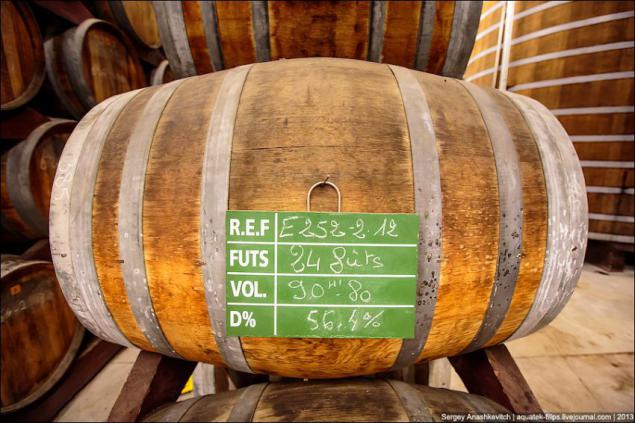
This marking a small distillery Boulard distillery Lecompte, where the cellar master showed a truly royal generosity by agreeing to demonstrate that they usually do not show - the location where the most expensive in the world and the most secret assemblage of Calvados - Lecompte Secret. And even offered to taste it. The taste of the drink is really much different from the Calvados that has been tried before.
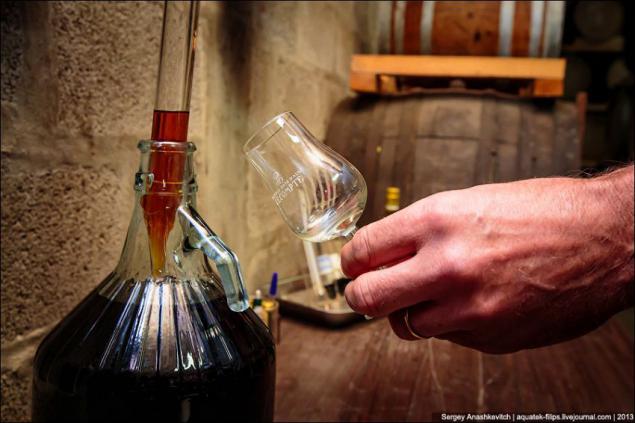
Workplace cellar master. Here are stored samples of various assemblages of production for many years.
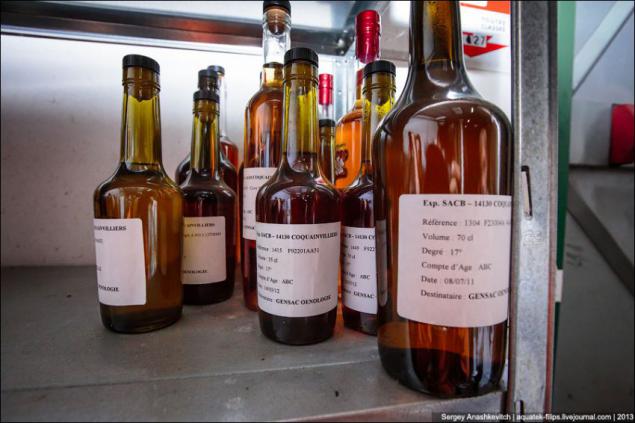
Richard tells how is control of the parameters on aging Calvados. It turns out that just is not enough to measure the fortress. There are various methods of calculations required to produce data (to be honest, there's the devil himself a leg break)

To do this, there are a Talmud with figures
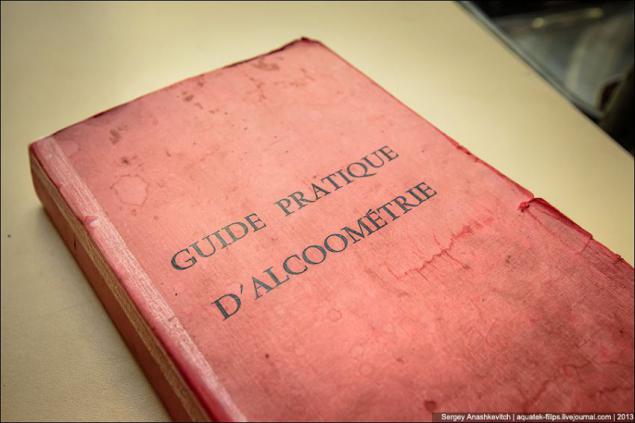
Hundreds of pages of different numbers

There are several types of Calvados: - young, called Fine. His endurance is 3 years - VO His endurance is not less than 4 years of age - VSOP Exposure at least 5 years - XO Exposure at least 6 years, but major producers kept XO at least 10 years.
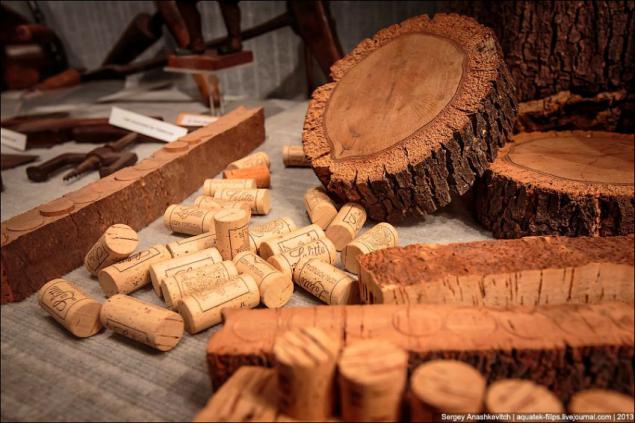
The right to be called calvados drink gets only after pass strict control and will be confirmed by its organoleptic qualities. This feature provides Tasting Commission INAO (Institut National des Appellations d'Origine)
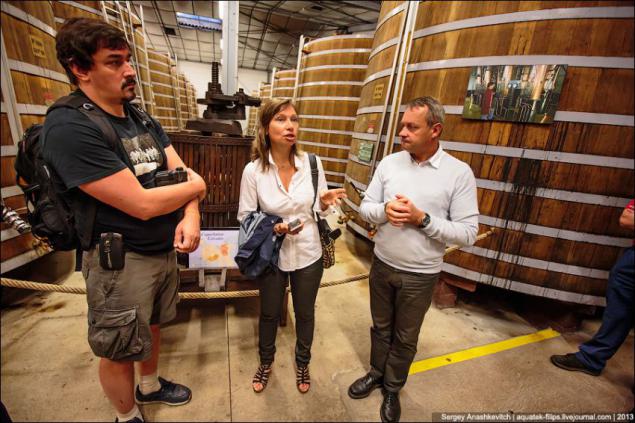
Calvados goes well with many types of dishes. In Normandy, there is an interesting tradition - trou normand (Norman hole) - this is a small shot of Calvados (10-20 ml) and drunk in the middle of a hearty meal. It stimulates digestion and promotes the resumption of appetite. Why such a name? In the Middle Ages the Normans believed that calvados burns a hole in the hard-packed food in the stomach. Today in France Calvados can be drunk as an aperitif, digestif, as well as in cocktails
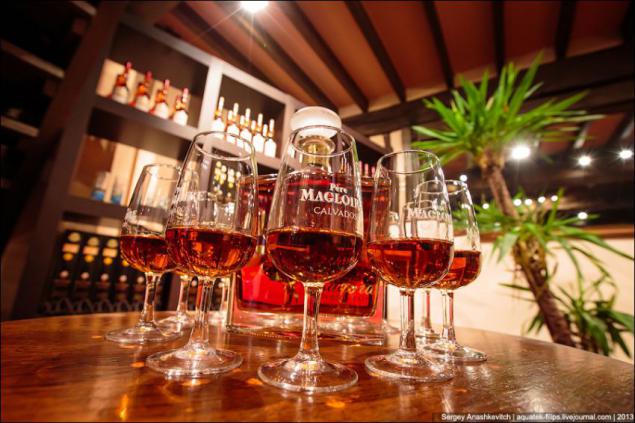
Despite the fact that only a few decades Calvados as a burst of market uncertainty, its history goes back far into the century. That is why, on the market today can be found on sale quite old and expensive items. For example, the Pere Magloire in 1969 ...
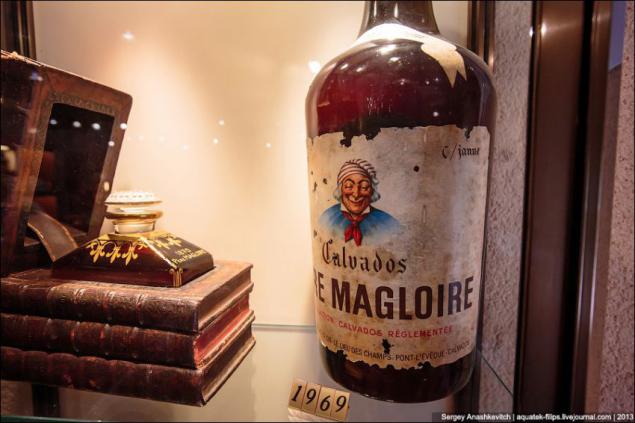
Or already mentioned above Lecompte Sevret and costs EUR 2,400 per bottle. The composition of the assemblage kept secret, but the cellar master misspoke, that the age of alcohol is not less than 50 years
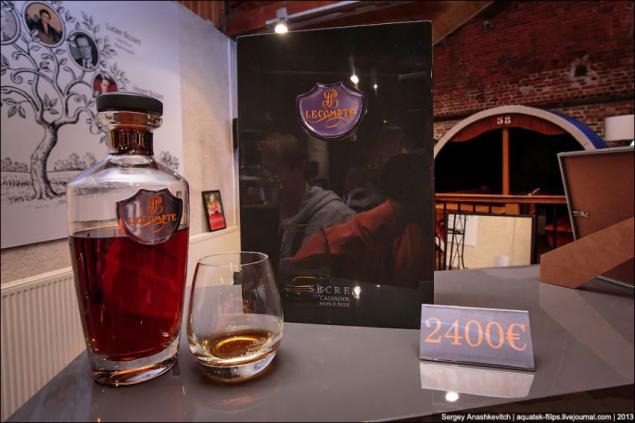
However, the bulk of Calvados, which companies are offering on the market is, of course, it is not such mad money. In fact, this drink can be purchased for as low as a few tens of euros per bottle. However, the longer the delay, the more expensive will Calvados.

It should be said about the taste of the drink. I must say that this trip was even my first acquaintance with calvados - never before I did not drink. Despite the similarity in production technology with cognac, calvados taste quite different from it. It is a fruity tone, which, depending on age and assemblage may contain a variety of shades. For example a young Calvados (Fine) has a pure fruit tones, it still does not feel an excerpt. The drink, which was in the barrel gets from her, and the color and tannins, and additional flavors. Often, pure fruit apple evolves in taste apricots, sometimes even walnut and caramel. More seasoned Beverage (XO) have a rich amber color and not as "soft" taste like VS and V.S.O.P. Aged strict perennial Calvados more suitable for special moments, and the young are often used in cocktails and also in cooking
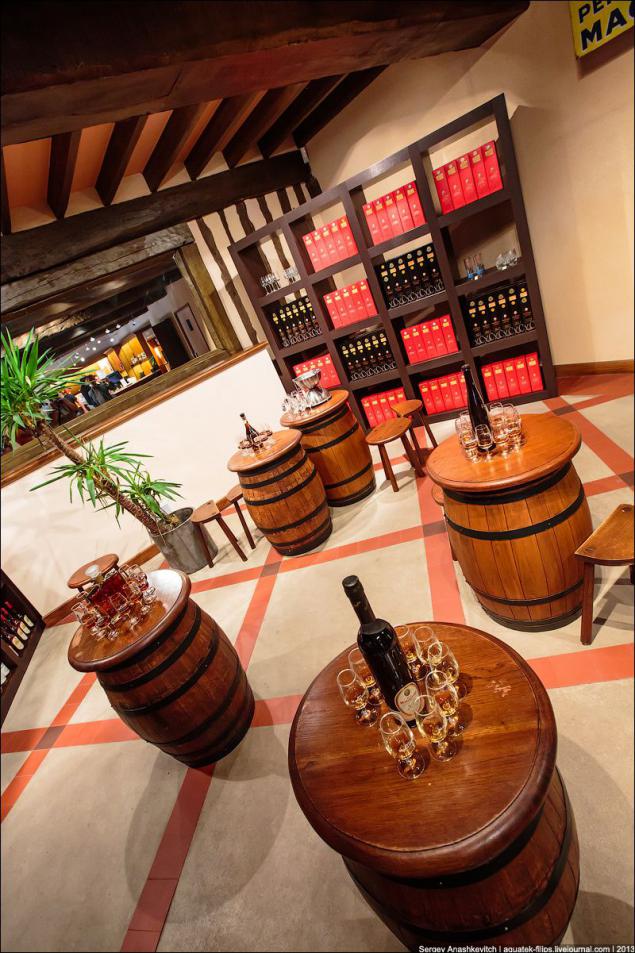
Source: aquatek-filips.livejournal.com
Every year in Normandy spreads around 3 million bottles of Calvados different periods of exposure. Especially love it in Germany, Japan, the United States and in Russia.

Calvados definitely should appeal to all fans of Steve Jobs and the products Apple. After Calvados is made from apples and many images associated with it there is an apple. However, not bitten. In the picture a basement distilerii Boulard.

With what begins Calvados? And it begins with Calvados. This department in Normandy, whose name and named the drink. And calvados can be called only one drink that is made in this department (by analogy with cognac and champagne). Everything else - the apple brandy. It is here that millions of apples are grown, and then finds a second life in the barrel and bottle. Like most other regional French food with a long tradition of manufacturing, Calvados is produced in strict accordance with the system of Appellation d'Origine Controlee, or AOC (the name translates as controlled origin). It is a set of rules that guarantee the authenticity of the product made in a particular area and determine the methods of its production as close to traditional. There are three appellation Calvados - the base (about 70% of total production), Pays d'Auge and Domfronte. This Pays d'Auge the highest quality (in detail about the differences I will discuss below) and Domronte content pears in Calvados with a share of at least 30%

Basis calvados apples. Manufacturers use only small and very fragrant apples. They are called "apples for cider." In Normandy grown hundreds of varieties of apples, but only 48 of them are recommended in the Pays d'Auge. Unlike wine, the production of which use one or only a few grapes for calvados, a combination of aromas and flavors of many varieties.

Depending on the acidity, bitterness, sugar and tannins, apples for Calvados is divided into four categories - bitter, bittersweet, sweet and sour. Manufacturers, strictly following traditions grow from 20 to 40 varieties of apples. Calvados Domfronte to grow these special varieties of pears.

Only a combination of different varieties of apples, calvados acquire the necessary softness, aroma and rich flavor. Normally it takes 10% of bitter apples, 70% of sweet and sour, slightly sweet, and around 20% acidic. In Domronte use 30 percent or more of pears. This Calvados is a more fruity. Apple harvest season is in September.

Between apples and calvados is another intermediate - cider. To obtain it, the apples after harvest and washing must be crushed or ground. To this end, the apples fall into a special press, grinding them to the desired consistency. After grinding, the pulp (or fruit mash) is several hours in a special container, where it is maceration. What is it for? The fact that most of the taste and flavor is obtained from the fruit peel. After maceration the pulp goes to press where the juice is separated from the pomace. From one tonne of apples get about 650 liters of juice.

. The next stage - fermentation of cider. To do this, the juice is poured into oak barrels of large size, where it is about 6 weeks. Top manufacturers fermented cider longer, and sometimes even a little stand in front, followed by distillation. Large manufacturers usually do not grow apples and cider making, purchasing it as a raw material in the tested farms appellation.

In the production of cider monitored alcohol content, which must be at least 4, 5 percent. Some manufacturers also bring it to 6-7 percent.

Workbook, which recorded figures during fermentation cider

Once the cider is ready, it's time to distillation. Only a small amount of time in the year, you must get the keys of the premises with alembics. All other months, they will wait for the next season

so ready to carry the cider distillery, where it will be subjected to distillation. There are two kinds of distillation - distillation alambikah Charente type and a direct continuous distillation in the cube. For the Calvados produced in the Pays d'Auge appellation obligatory double distillation. This process is more complex from a technical point of view, a long and consuming more time than single distillation. But it makes Calvados very different in quality.

How is distillation? First, the cider is placed in a tank called shof cider (pictured maroon capacity on brick "hourglass" in the middle). Where cider is preheated using the vapor coming from the bottom. From cider is fed by gravity into the cube on the right (it is not visible, it is inside the brick structure with oven below). In fact, this pot with a helmet on top. The helmet rectified pair of cider, which go up and then move to the condenser tube (left maroon capacity). Inside this coil is placed in cold water. Here, a pair of alcohol and condensed into a liquid, which enters the holding tank

Distillery cellar master Richard talks about the distillation of Calvados

The furnace, which is located above the boiler with cider. Previously used as fuel wood, but now gas.

The sensors on the pipeline leading to the coil. That moved him a pair of alcohol

Does this mean that after the distillation of Calvados is bottled and fall on the table? In no case! This is only the beginning of his long journey. Then begins a long life in a barrel ...

Calvados leaves alambik colorless. And he has not yet called Calvados, but the de-vie (water of life). At the request of the appellation Calvados be kept for at least two years in oak barrels. Why is this done? At a young Calvados strong aroma of fresh apple, and it is transparent. Now he needs to evolve to give color and flavor to balance its flavors derived from the oak barrels. In addition, the barrel gives the drink amber hues. As a result of the interaction of alcohol, wood and air Calvados gets subtlety of aromas and full flavor.

There are many types of barrels - from huge to small containers 300 and 400 liter. Barrels may be different calcination degrees, new, secondary or older.

Young alcohols usually kept in new barrels from which they receive the necessary counterbalancing tone tannins and aromas. And only then Calvados poured into older barrels.

In general we must say that not as a wine Calvados lives all the time in a barrel. He is regularly poured, mixed with other Calvados, spending assemblage. Behind all this every day watching the cellar master, constantly taking samples and tasting flavors and taste.

Each barrel has its own marking. For example, here it indicates that it has a capacity of 295 liters, the height of the middle part of 70 cm. Now it is filled to the level of beverage 57 centimeters and its barrel 265 liters. Fortress 54 degrees. The barrel millezimnyh drink that flooded in 2004. Millezimnyh means that it is the drink of one year is not mixed with any other.

This is a very old barrels in which to extract contains Calvados 1988

At different distilleries marking its barrels. For example, Pere Magloire distillery barrels contain a code in the registry, the number of barrels of this beverage, the amount in a barrel and strength

This marking a small distillery Boulard distillery Lecompte, where the cellar master showed a truly royal generosity by agreeing to demonstrate that they usually do not show - the location where the most expensive in the world and the most secret assemblage of Calvados - Lecompte Secret. And even offered to taste it. The taste of the drink is really much different from the Calvados that has been tried before.

Workplace cellar master. Here are stored samples of various assemblages of production for many years.

Richard tells how is control of the parameters on aging Calvados. It turns out that just is not enough to measure the fortress. There are various methods of calculations required to produce data (to be honest, there's the devil himself a leg break)

To do this, there are a Talmud with figures

Hundreds of pages of different numbers

There are several types of Calvados: - young, called Fine. His endurance is 3 years - VO His endurance is not less than 4 years of age - VSOP Exposure at least 5 years - XO Exposure at least 6 years, but major producers kept XO at least 10 years.

The right to be called calvados drink gets only after pass strict control and will be confirmed by its organoleptic qualities. This feature provides Tasting Commission INAO (Institut National des Appellations d'Origine)

Calvados goes well with many types of dishes. In Normandy, there is an interesting tradition - trou normand (Norman hole) - this is a small shot of Calvados (10-20 ml) and drunk in the middle of a hearty meal. It stimulates digestion and promotes the resumption of appetite. Why such a name? In the Middle Ages the Normans believed that calvados burns a hole in the hard-packed food in the stomach. Today in France Calvados can be drunk as an aperitif, digestif, as well as in cocktails

Despite the fact that only a few decades Calvados as a burst of market uncertainty, its history goes back far into the century. That is why, on the market today can be found on sale quite old and expensive items. For example, the Pere Magloire in 1969 ...

Or already mentioned above Lecompte Sevret and costs EUR 2,400 per bottle. The composition of the assemblage kept secret, but the cellar master misspoke, that the age of alcohol is not less than 50 years

However, the bulk of Calvados, which companies are offering on the market is, of course, it is not such mad money. In fact, this drink can be purchased for as low as a few tens of euros per bottle. However, the longer the delay, the more expensive will Calvados.

It should be said about the taste of the drink. I must say that this trip was even my first acquaintance with calvados - never before I did not drink. Despite the similarity in production technology with cognac, calvados taste quite different from it. It is a fruity tone, which, depending on age and assemblage may contain a variety of shades. For example a young Calvados (Fine) has a pure fruit tones, it still does not feel an excerpt. The drink, which was in the barrel gets from her, and the color and tannins, and additional flavors. Often, pure fruit apple evolves in taste apricots, sometimes even walnut and caramel. More seasoned Beverage (XO) have a rich amber color and not as "soft" taste like VS and V.S.O.P. Aged strict perennial Calvados more suitable for special moments, and the young are often used in cocktails and also in cooking

Source: aquatek-filips.livejournal.com








